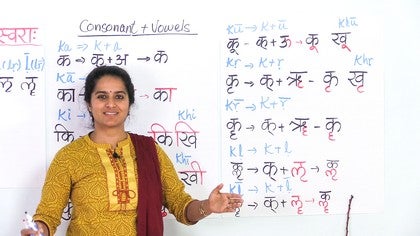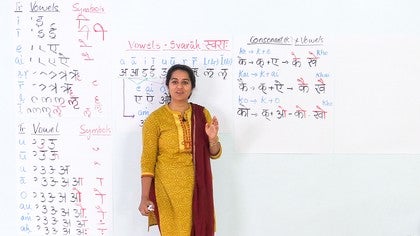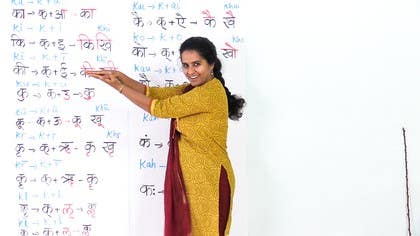Description
About This Video
Transcript
Read Full Transcript
Namaste friends, hope you've had a good time practicing with the consonants combining with the vowels that we saw in our previous session. Let's move on to the remaining vowels and see how they combine with the consonant K. So we had the consonant K with the vowels. The vowels that we had seen last time were the É? É? ɪ ɪ �u É? É? É? É? É? É? É? so the combined with É? would give us the K. K with É? was the K. K with ɪ was the K. k with e is the key, k with u is the ku, k with u is the ku, k with z is kru, k with u is the kru, k with l is the kru and kru, combination of kru and l, l, kru. These five corresponded to the five places of pronunciation. Now when these vowels combined with each other and give us the a, let us see what it looks like when it's combined with the consonant k. So we have the transliterated form k which is a combination of k plus a. In the Devanagari script which is often used to represent the Sanskrit language, it would be represented as k and that is a combination of the phoneme k which is represented by adding a small mini backslash beneath it that gives you just the sound k plus the vowel a which is what brings the consonant into manifestation. So we have the k and that looks like this. The a turns into a symbol which is a single antenna on the head. When we were just seeing what the vowels corresponded to with the symbols, we saw that the a was that, a single antenna but we didn't exactly know where it came. So now we have it here with the combination of the consonant and we have the consonant k and the antenna comes on the head of the k. But like we saw in our previous session, there are some letters which have a double head that touch that line on top. In that case like a letter k, you see there are, it has two places of touch on that line on top and in that case the antenna will come on the second head k. I will write it out for you in transliteration so you know. So that's the k alright. We move on to the next vowel which is the i so we get the combination as kai which is, you break it down, k plus i. In the devanagari it would look like this, kai, kai and that is a combination of k. It's nice if it touches so k plus i, i. The symbol of the i as we see here is a double antenna and as we saw with the a, it comes on top of the head so it would be represented like this, k and i, kai. In the case of a letter with a double head touch, it becomes a kai where the two antennas come on the second head. That could have been a red like that but that's just for our color code so that you know what I'm meaning when I write it that way and the transliteration would be kai. There we go. The next set of these terms are the o and the o and we see that it falls into the group of the o there. So we have the o like that. In transliteration it is the ko, combination of the k plus the o. In the devanagari it would be the ko so that and that would be a combination of the letter k plus the vowel o. That gives us together the ko. Got it? That's the ko. I will also show it to you with the letter k having the double heads because sometimes if one doesn't pay attention to the extra line then it can end up becoming a different letter altogether or a different sound and we have the next letter which is k plus o which is the ko. You see now if you forget to write that extra line and you put the antona directly on the top of the letter itself you will end up getting a k and it would sound completely different. It would become a different word. Now the beauty about the Sanskrit language is that there is very little scope for error. You have to get it spot on and that is also the uniqueness of this letter where it requires hundred percent mindfulness. One has to be very precise with the pronunciation of the sound. Ko is very different from k. Color which doesn't mean anything and then you say color it means a bad person. So if you say if you want to indicate a bad person but why would you want to do that? Just for an example you then if you say color it won't mean. So even in the terms of the combinations with the vowels that will be more precise. If I say something like kala which is a long vowel with the k you get kala which means time. Now if I change the position of the long vowel and I say kala I get a word which is meaning art. So kala and kala. I'm exaggerating the length of these sounds for you so that you hear the difference and it's important to be able to hear the difference initially so that when you say it fast you will still respect the duration of the vowel. So said fast it would be kala kala kala. But as you notice even when you try and say it fast you really have to give it its time. So Sanskrit is a language that forces you to pause. It forces you to be there. Be there in the fullness of your being. And therefore when you are speaking it pronunciation has to be correct. When you are writing it again there is little scope for error because it would change the sound completely. And when we get into the formation of the words and the formation of the grammar all of that is a very precise way of mapping out the world. But when I say it is precise it is not a language which is very rigid. It is a certain precision because that is the need. It's like the order. When you follow an order there is a need to do it in that way because that is the best way of doing it. But there can be many ways of arriving at it. So if I want to go from here to farmer and the cook I can take a particular road. There would be the shortest road of getting there. But I can choose to take many other roads to get there. Yeah get that. So we will move on to the next vowel which is the ow and we have cow. Cow is k plus ow. In Devanagari it would be k and ow. Combination of k. One has to get used to that. So k plus ow which is an extra stick with a double antenna on it and this gives us the cow. And now you can imagine the same with the cow. Instead of a single antenna there will be a double antenna. But you have to keep that thing in mind. We get it k, kai, ko, cow and then we have the last two sounds which are the kam and the kaha where it is combined with the anuswara and the visarga aha. Let's go on to that. We have kam which is a combination of k plus am. Am is the anuswara. I'll write it out for you. Anuswara. Okay am. So kam. Put that in brackets because describing that. Kam.
In Devanagari it would be like this. Kam. And that is a combination of k plus um which is I'm putting the line in red that it's easy for you to remember the placing of the dot. So it's a kam. The last one is the kah or with the visarga the aspirate sound and it's written like this. Kah. Combination of k plus the visarga or aspirate sound ah. I will write it for you. Visarga. In Sanskrit it is represented by the two dots that we saw down there. So this is in Devanagari represented like that. Kah. The line over the head. Combination of kah plus aha which gives us kah. So there you are. Now we've combined the consonant k with all the different vowels but let's for our own practice let's just repeat this once. So we have k plus a, k, k plus i, kai, k plus o, ko, k plus o, kao, k plus um, kam, k plus ah, ka. Now you want to try saying that once? Very good. K plus a, k. Very good. K plus i, kai. Next. Very good. K plus o, ko. Next. K plus aho, kao. Just draw your attention. Make sure you're saying aho and not eho or something else. Okay so it's an aho. So kao. Very good. We go on, k, kam. Yes. K plus um, kam. Finally, k, aho. Very nice. K plus ah, ka. Isn't that a relief? So I hope to see you again. We'll try and put them all together and just visually try and recognize the symbols as they combine with the consonants. So stay with me.
Mother Tongue: Writing the Vowels
Comments
Enjoy identifying them in Sanskrit literature wherever you can :)
So happy to hear you are enjoying your experience of Sanskrit. This 'craving' will nourish your being at all levels .. dive deep and get intoxicated :)
You need to be a subscriber to post a comment.
Please Log In or Create an Account to start your free trial.














